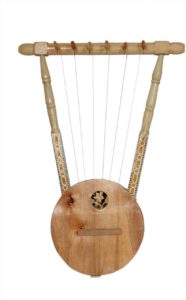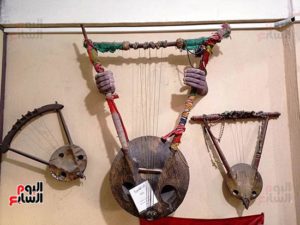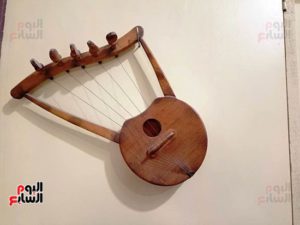Semsemia instrument
Semsemia is a stringed musical instrument consisting of three wooden legs in the shape of a triangle. The length of one wooden pole is 60 cm. The pole on which the strings are stretched is called the “crossbar” ” Farman” or ‘Hamalla”. The holes were from five to six, then to eight, and then to ten until they reach twelve. Inside these holes are the keys, or what is also called the “Malawi” or the “Kalon”. The strings within the communities concerned with the Semsemiah instrument have different names that are known by all the players and the maker of the instrument, strings are the same in type, length, and thickness, and the sound they produce varies depending on the size of the instrument, as well as the process of pressing or leveling. Sometimes the player is a maker of the instrument, craftsmen- some of them are women- strive to develop the instrument, while maintaining its traditional form and function. It is rare for a festive occasion in the concerned communities to be devoid of playing Semsemia instruments. Playing it is usually accompanied by performing traditional songs and dances and could be solo, although it is often in a band accompanied by other traditional instruments such as as percussions and traditional wind instruments. Bearers of Semsemiah instrument skills and knowledge are mainly the players and craftsmen of it from both genders and from different age groups.
The performance is completed by the interaction of the audience from the communities who participate in the performance in social occasions and in public cafes, sometimes by dancing or chanting with the band. Trainers of instrument playing in the cultural centers in the communities in which the element is transmitted to new generations from both genders. There are many NGOs and ethnomusicologists concerned with the instrument, such as the Mastaba Association in Port Saeed.
Semsemiah instrument has a crucial role in the daily life of the concerned communities upon its participation in the social events either related to individual’s life cicle (birth or marriage celebrations) or in pilligram or in the local celebrations of the national events; such as celebrating easter ” Sham El Nassim’ in the cafes and on the beaches, The Semsemiah songs, no matter how simple, reflect the social relationships and values that communities, groups and individuals are keen to transmit through generations, additionaly, Semsemiah has a function of entertainment through evening performances in modest traditional cafes, where one of the players begins to play it, and people gather, which enhances social ties among members of the community. Semsemia is one of the cultural features of the Suez Canal cities, it is closely associated with the sea as it is present on any ship or on fishing boats to entertain fishermen on fishing trips.




